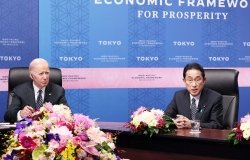The Road to Copenhagen: Energy Solutions for Emerging Economies
Technology and innovation will be critical for China, India, and other emerging economies to reduce energy consumption and carbon emissions – and U.S. technology policy can help lead the way, say experts David Irvine-Halliday, Chen Wang, and Anuradda Ganesh.
Overview
Technology and innovation will be critical for China, India, and other emerging economies to reduce energy consumption and carbon emissions – and U.S. technology policy can help lead the way. New technologies such as solid state lighting systems, efficient nanocarbon materials and biomass energy offer hopeful prospects that can lead to equitable and sustainable development. On November 5, 2009, the Wilson Center on the Hill, along with the China Environment Forum, and Science and Technology Innovation Programs of the Wilson Center and the University of California at Santa Barbara co-hosted Senator Ron Wyden (D-OR) and three leading experts to discuss these contemporary issues. David Rejeski, director of the Science and Technology Innovation Program moderated the event.
Remarks by Senator Wyden and David Rejeski set the stage for presentations by the three experts. Senator Wyden suggested that nanotechnology can produce big dividends on some of the major issues of the day, including health care, energy and climate change. In health care, nanotechnology has the potential to open the door to better treatments at a lower cost. In the energy sector, it can both help the environment and put people to work. Senator Wyden cited the example of biomass energy technologies, which can be both environmentally responsible and have been a source of good paying jobs in his home state of Oregon. For these reasons, it is crucial that technological innovations move out of the laboratory and into production. The Senator commended the efforts of the Oregon Nanoscience and Microtechnologies Institute (ONAMI) for bringing technological innovation to industry. Rejeski added that while most Americans know very little or nothing about nanotechnology, it accounts for about $150 billion of the economy, and this number is rapidly increasing. Research is paying off in the form of commercializing important new battery technologies, fuel cells, and nanosensors.
Bringing cost-effective stand-alone LED systems to provide light for the developing world can bring educational and economic gains to those regions, according to David Irvine-Halliday, founder of Light Up the World and Professor at the University of Calgary. With their own battery pack and solar panels, these LED systems can bring reliable light to even the most remote villages. According to Irvine-Halliday, an average village in the developing world uses kerosene for lighting. If that kerosene system is replaced with a lifetime LED system, the village will more than save the cost of that system in an average of one year and also significantly reduce greenhouse gas emissions that year and into the future. In 1997, within two years of founding, the organization had demonstrated their first generation LED light project in Nepal. Since then, the technology has improved significantly, making the systems even more efficient and practical. If a cost-effective scalable business model could be found, this type of LED and solar panel technology could replace incandescent and CFL technologies in the developing world. For villages that currently have little or no lighting, this technology would allow them to "leapfrog" the current inefficient and costly alternatives for providing electrical service in a way similar to how cell phone technology was able to open up communications for villages too remote to get access through conventional land line technology.
Anuradda Ganesh, head of the Department of Energy Science and Engineering at the Indian Institute of Technology Bombay, provided her perspective about innovation and energy solutions for India. She explained that India is fast growing, has a large untapped energy market and is "deeply concerned about the environment and resources." According to Ganesh, although both developed and developing countries have similar emissions and climate change goals, they view energy solutions from different perspectives. In India, a newly industrialized country, it is important that energy solutions be both reliable and highly cost-effective. Technological innovations must have a business model so that it can feed into the economy, and help the country develop.
The Department of Energy Science and Engineering at the Indian Institute of Technology Bombay is actively working on four national objectives— to double the country's power capacity by 2012, have renewable sources of energy constitute ten percent of energy market share, promote distributive power generation, and implement total village energy security. Ganesh called for greater development of national research, testing, and assimilation facilities in India to move technology innovation from the laboratory to the wider market.
Chen Wang, director of the National Center for Nanoscience and Technology of China, argued there is a need for diverse and focused efforts to deal with China's energy challenges. He noted that currently, there are 11 million people in China that have no access to electricity, and there about 200 million people in the country that live below the international poverty line. These people, many of whom live in rural areas, use very little energy. Technological advances can bring more low-cost, reliable energy to the rural poor to improve their quality of life. In contrast to expanding rural access, the goal for China's city population is to reduce energy consumption. Wang emphasized that developed countries should consider these different perspectives as the international community gets together to formulate collective efforts addressing energy and environmental concerns.
During the discussion that followed the presentations, Ganesh noted that those involved in the energy debate should acknowledge the need for differentiated responsibilities. She also said it is important to distinguish between absolute and relative energy savings. The first is a pure reduction of emissions, possibly with the use of carbon capture. The latter is particularly relevant in developing countries—to reduce energy consumption while maintaining a platform for increased economic growth.
Drafted by Matthew Clarkson.
Speakers
Hosted By

Environmental Change and Security Program
The Environmental Change and Security Program (ECSP) explores the connections between environmental change, health, and population dynamics and their links to conflict, human insecurity, and foreign policy. Read more

China Environment Forum
Since 1997, the China Environment Forum's mission has been to forge US-China cooperation on energy, environment, and sustainable development challenges. We play a unique nonpartisan role in creating multi-stakeholder dialogues around these issues. Read more
Thank you for your interest in this event. Please send any feedback or questions to our Events staff.










